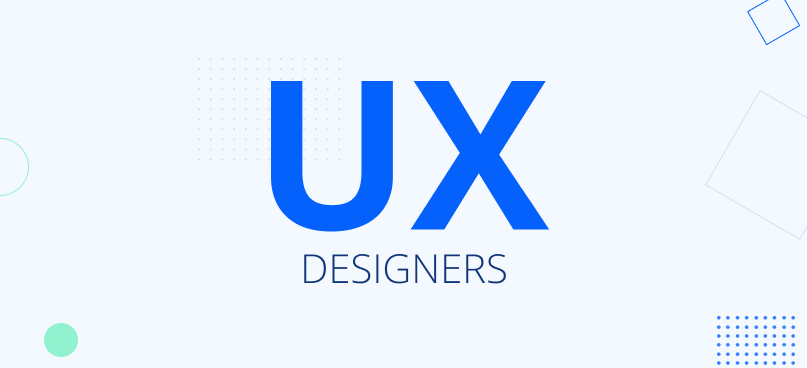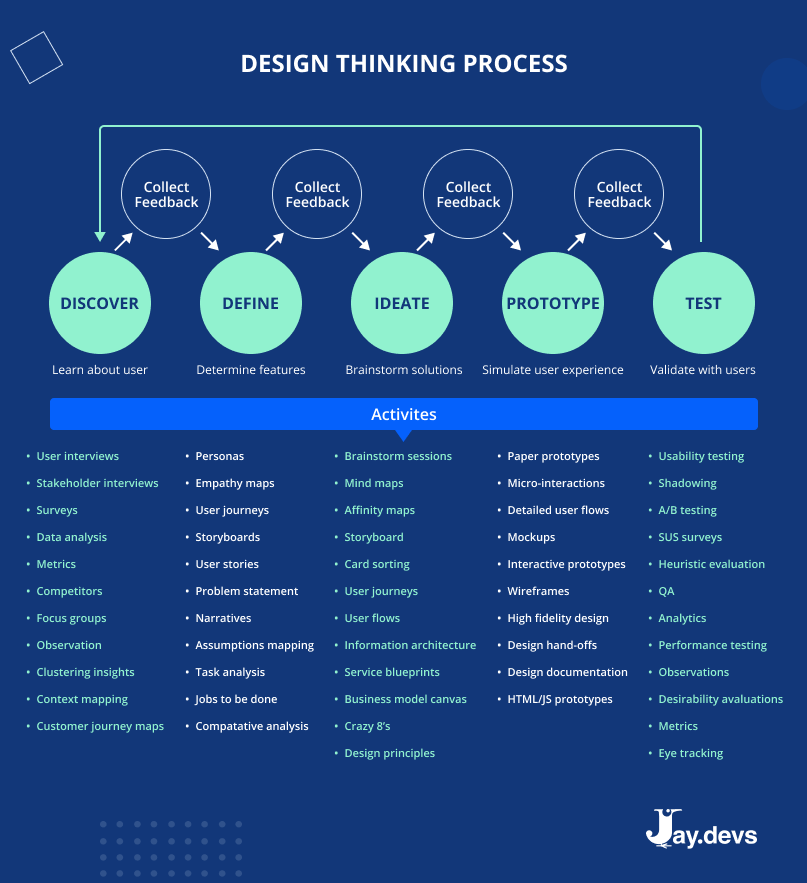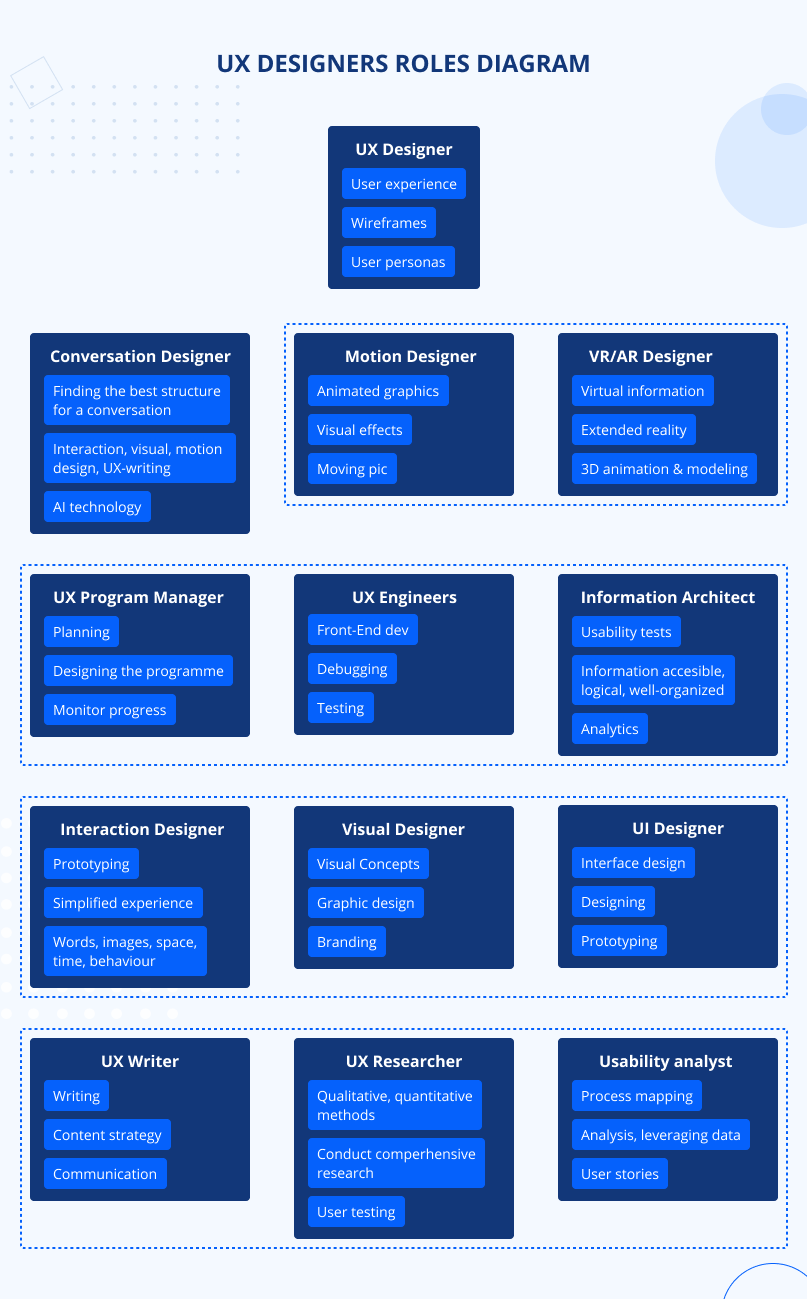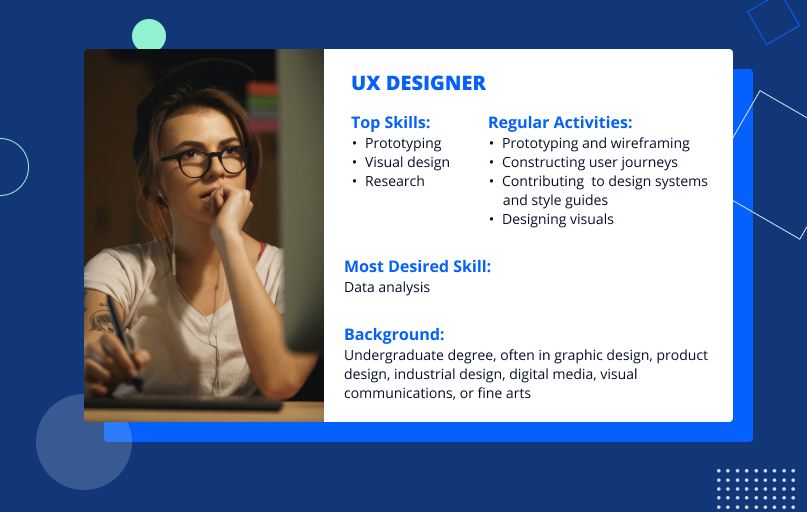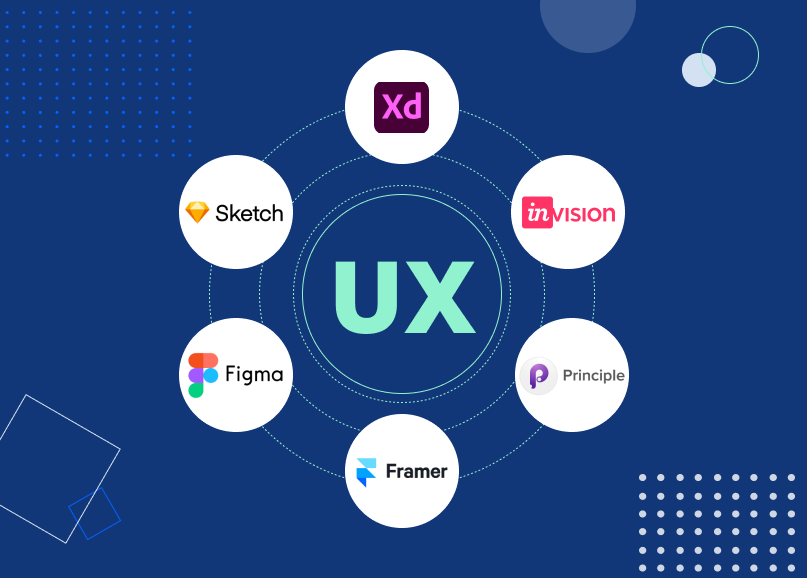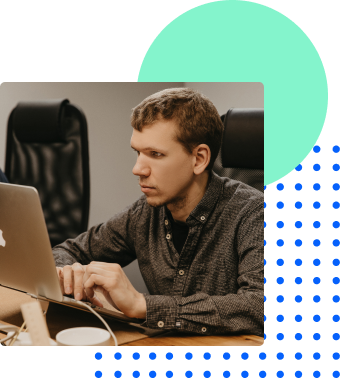It’s common in the software development industry for even the best ideas to fail due to poor execution and user experience (UX) — and vice versa.
Getting the right UX designers can be difficult because the market is highly competitive. Talent UX designers being picky about their projects, it’s well worth the effort to find at least one designer. That’s why we’ve prepared this guide for you.
- 1. What Is UX Design?
- 2. A UX Designer Responsibilities
- 3. Why Hire UX Designers?
- 4. Ways to Get UX Services
- 5. Types of UX Designers
- 6. Must-have Skills of a UX Designer
- 7. Steps to Hire a UX Designer
- 8. How to Shortlist UX Designers
- 9. Things to Look for in a UX Portfolio
- 10. Hiring a UX Designer: Red Flags
- 11. Common UX Design Tools
- 12. Hourly Rates and Cost
- 13. Interview Questions
- 14. Mistakes to Avoid When Hiring a UX Designer
What Is UX Design?
UX design is a systematic process of designing software products or apps to ensure an excellent user experience through ease of use and intuitive operability. The goal is to create products that are not only functional but also pleasurable to use. A great user experience helps your app stand out from the crowd.
The best designers will have a strong understanding of user research, interaction design, visual design, information architecture, etc.
What Does a UX Designer Do?
A UX designer is responsible for planning the user experience of an app, web page, or software product to make it fully functional and easy to use. They achieve this by conducting user research, designing effective interfaces, developing ideas for landing pages, and creating engaging visual designs.
- User Research: Typically, a UX designer starts with user research to help them understand the needs and wants of their target audience. They use this understanding to design products better suited to the users’ needs.
- Persona creation: Personas are fictional characters representing the different types of users using a product. By creating personas, UX designers can better understand the different types of people using your products.
- Interaction design: After conducting comprehensive user research and identifying the preference and pain areas, UX designers proceed to interaction design. Here, a UX designer outlines how a user will interact with the product or navigate through the interface to achieve the app’s or product’s desired functionalities.
- Visual design: Their next task is to create visually appealing designs that are effective and easy to use. Visual design focuses on the aesthetics of a site and its associated contents by strategically integrating images, colors, fonts, and other components.
- Information architecture: UX designers structure information to make it easy to understand, navigate, and use.
- Wireframing: Wireframing is the process of making a blueprint that shows the interactions, elements, navigations, and components of the app or page. It is a low-fidelity representation of the product that allows designers to experiment with different layouts and designs.
- User testing: Finally, designers test the product with real users to see if they have met their mark. User testing helps designers identify areas that may need improvement and confirm that the design works as intended.
Overall, the UX designer’s job is to ensure that the user’s experience is simple and pain-free every step of the way.
Do I Need a UX Designer?
As a product owner or development manager, you might wonder if you really needs a UX designer. After all, can’t the developers just build something that works well and looks good?
The answer is, unfortunately, no. A good developer can create a functional product, but it takes a UX designer to create a product that is both intuitive and enjoyable to use.
A designer can proactively find out the user’s expectations from your app and recommend effective solutions based on their findings. As a result, they help create a winning product that meets those needs and aligns perfectly with your business branding. This includes the look, features, and intuitiveness of your app, icon, logo, website page, or landing page.
A good UX designer can also recommend the best ways to avoid poor user experience down the lane, as they have a deep understanding of how users interact with products and what works well — and what doesn’t.
Which projects are UX designers useful for?
Almost any project can benefit from hiring an UX designer. However, there are some types of projects that are particularly suited to UX designers:
- Complex projects: A UX designer can be invaluable when the project is a complex one that a wide variety of people will use. Designers help you create a simplified, streamlined, functional design to improve the overall user experience.
- Customer-facing projects: They can correctly identify your customer’s expectations and pain points to help address those areas with a solution.
- Innovative products: If you are working on an innovative product or trying to push the boundaries of what is possible, then a UX designer can be very helpful, as they can help you create ground-breaking and simplified designs.
Why hire UX designers?
Great user experience design can help your business in several ways:
- Creating products that are easy and enjoyable to use
- Producing innovative ideas to match your page with your brand’s logo
- Attracting and retaining customers to support marketing activities
- Increasing customer loyalty by creating a brand identity
- Increasing sales and conversion rates to help you achieve your business goals
- Decreasing customer support costs
- Helping graphic designers create excellent illustrations
Different Ways to Get UX Services
There are several ways to get UX services. You can hire a freelance user experience designer, contact a dedicated development company, or hire an in-house UX designer. There are pros and cons to all. Let’s take a look before you evaluate your hiring needs.
Hire a freelance UX designer
When you have a tight budget for hiring a UX designer, you may save money by onboarding a freelancer or a contractor.
Pros of hiring a freelance UX designer
- Cost. When you recruit freelancers, you only pay for their work at completion or for the hours they’ve worked. You won’t need to worry about employment-related expenses such as benefits, paid leaves, vacation days, and medical costs.
- Easy-to-access remote skills. You can find and hire a freelance designer from almost anywhere. The wide availability of the internet has made it easy and quick to connect with many skilled UX designers regardless of their geo-locations.
- Specialized skills. For example, if you need help designing an app, you can find a freelancer specializing in app design.
- Deadline. Working with freelance UX designers allows you to set your own deadline. When you are on tight deadlines, you may hire additional designers or ask them to work extra hours.
Cons of hiring a freelance UX designer
- Reliability. When you hire a freelancer, you rely on that person to get the job done. But most freelancers manage multiple projects at once to make sure they use their time effectively. However, they sometimes fail to evaluate the scope and timing required to invest in a specific task.
- Security. Freelancers have access to the company’s systems, data repositories, and process documents. You must ensure they are not privy to sensitive information.
- Communication. It can be challenging to communicate with freelancers, especially if they’re in a different time zone from you. There can also be language barriers.
Working with a dedicated UX development company
Pros of working with a dedicated UX development company
- Professionalism. You can expect a high level of professionalism from companies or agencies when you hire remote UX designers. Dedicated software development companies typically share detailed work plans and a tentative timeline before they start working for you.
- Access to a diverse range of talents. You can take full advantage of a team of designers with different skill sets, which is handy when your project is particularly complex and needs to accommodate a wide variety of users.
- Timeliness and reliability. You can expect a dedicated development company to be timely and reliable. A dedicated company can form a diverse team of designers and professionals, and multiple people may work together to help you achieve business goals. This will substantially reduce the risk of missing deadlines.
- Quality and handling complexity. A company may have dedicated designers with different individual expertise and specialties. So you can expect high-quality output for complex projects and UX services.
- Cost-saving. When working with dedicated UX developers, you won’t have to worry about any additional expenses related to employee benefits, as the dedicated software development company will take care of those. Thus, you will save money in the long run.
Cons of working with a dedicated UX development company
- Different Time Zones. It can be difficult to communicate if the company you’re planning to hire is located in a different time zone. There may be a time difference of several hours or sometimes a full working day, which can make it challenging to get in touch with someone when you need to.
- Cultural differences. There may be different and unfamiliar customs and traditions to deal with. For instance, what is perfectly normal in some cultures, may sound impolite elsewhere, so it’s important to make sure that everyone is on the same page when working with teams from other parts of the globe.
Hire an in-house UX designer
An in-house user experience designer is a person who works in your company’s office full-time. Pros and cons to hiring an in-house UX designer.
Pros of hiring an in-house UX designer
- Product experience. An in-house UX designer will have a deep understanding of your product. They can help find a better solution for your business goals and brand identity.
- Long-term value. An in-house UX designer remains with your company and continues to support you with upcoming product developments over many years, which is a stable solution.
- Consistency. Because an in-house developer will stay with you and your company long term, they will work on all of your projects. Having the same person working on each business goal will bring a level of consistency that may not be possible when you outsource for every project.
Cons of hiring an in-house UX designer
- Limited skills. A designer may have a limited skillset and may not be able to help you with all aspects of your product.
- Cost. They are more expensive than other options and will require a salary and benefits. You will also have to follow your local regulations and comply with local regulatory bodies.
- Commitment. An in-house UX designer may require a long-term commitment from your company, which is sometimes inconvenient for start-ups.
Types of UX Designers & Responsibilities
User Researchers
They conduct user interviews, surveys, focus groups, and user testing. They use this data to understand user needs and pain points.
Information Architects
Information architects design and build the information architecture of the product. This includes creating sitemaps, wireframes, and prototypes. They need to have a strong understanding of UX design principles and how users interact with digital products.
Visual Designers
Visual designers create the visual design of the product. This includes the product’s color scheme, typography, iconography, and overall look. They need to have a strong understanding of design principles and how to create visually appealing designs.
Program Manager
The program manager oversees the whole project implementation. This includes setting deadlines, assigning tasks, and communicating with the client. Strong management skills and being able to keep the project on track are vital qualities in this profession.
What Skills Does a UX Designer Need?
When you hire UX designers, keep in mind that these are some of the skills that the best UX designers have:
- A solid understanding of human psychology
- Understanding how people interact with technology
- The ability to design simple and elegant user interfaces
- Wireframing and prototyping
- A good eye for aesthetics and attention to detail
- The ability to think outside the box and come up with creative solutions
- Excellent communication and collaboration skills
How to Hire a UX Designer and Write an Effective UX Designer Job Post
Now, you know how a strong UX designer can make a difference to your upcoming product.
Let’s now go over creating your job post step by step:
Define your requirements and scope of work
You need to be clear about what you want from the get-go. This will help you save time and weed out unqualified candidates.
Here are some questions to know before writing a job post while hiring a UX designer:
- What specific skills and experience is the ideal candidate supposed to have?
- What kind of project is it? Is it a short-term or long-term?
- Do you need a full-time or part-time UX designer?
- What is your budget?
- What is the project timeline?
- What roles do you expect the UX designer to play?
Answering these questions will help you get a clearer picture of the ideal candidate. It will also help you attract the right talent and avoid any miscommunication down the line.
Project length
You have two options: short-term and long-term projects.
Short-term projects are generally one-time projects with a specific deliverable. For example, if you want to create a simple app with some basic functionalities, the project is generally short-term, lasting for a few weeks or months.
In contrast, long-term projects require continuous and ongoing participation from your product development team for the foreseeable future.
When you have a short-term project, you might only need to hire a freelance UX designer. But if you have a long-term project, you might need to hire a full-time dedicated UX designer.
Background
Regarding the background of your ideal candidate, you have two main options: generalist and specialist.
A generalist is a person with a broad range of skills and experience. They are well-rounded and can handle different types of projects. On the other hand, a specialist is a UX designer with a specific focus. They have deep expertise in one area of UX design.
You might need to hire a specialist if you are working on a large and complex project. But if you have a simple project, hiring a generalist might be more efficient.
Budget
Your budget will also affect the type of UX designer you can hire. If you have a small or medium budget, you might only be able to afford to hire freelancers or dedicated developers. With a large budget, you can afford to hire an in-house developer or even a team of UX designers with different specialties and skill sets.
Check out portfolios
Once you know what you’re looking for, it’s time to start looking for candidates. The best way is to check out their portfolios. When looking at portfolios, pay attention to:
- The range of previous projects
- The complexity of the projects
- The results they have achieved
- The process they used
- The tools they used
Interview candidates
After you have shortlisted some potential candidates, it’s time to interview them. This is the best way to get to know them and see if they are a good fit for your company. We will discuss the interview questions later in this article.
Sign a contract
Once you complete a comprehensive evaluation process and find the right candidate, you should sign a contract. This will protect both you and the UX designer or IT vendor. Make sure that the contract includes scope of work, designing timeline, payment terms, and confidentiality agreement.
How to Shortlist UX Designers
You should keep an eye out for the following qualities while making sure that they have the required skill set:
- Relevant skills: Ensure that the shortlisted candidates have the skill sets that set for your project. Good UX designers should be well-versed in various software, such as Photoshop, Sketch, Adobe XD, etc. They should also have a good understanding of wireframing, prototyping, and user experience testing tools.
- Academic background: While a UX designer doesn’t need a formal education in design, it is helpful. For example: a degree or certification in human-computer interaction (HCI), interaction design, graphic design, or a related field.
- Past work experience: Ideally, you should look for a candidate with at least three years of relevant work experience to ensure they have the necessary knowledge to hit the ground running on your app or website.
- Strong portfolio: When assessing a candidate’s portfolio, look for examples of projects that are similar to what you want to create. Also, pay attention to the design process and see if the candidate understands it. The portfolio should also ideally be well-organized and present the candidate’s work professionally.
- Soft skills: It’s also essential to find a candidate with the right personality and attitude for the job. They should be able to work well in a team and be able to communicate effectively.
- Work ethic: Finally, you should ensure that the candidate has a strong work ethic and is passionate about their work. They should be able to work independently and be self-motivated.
If a UX designer has all of these qualities, then they are likely to be a great fit for your company.
What to Look for In a UX Portfolio
- Innovation: Does the designer have a knack for developing new and unique solutions?
- User Research: Does the designer conduct user research to inform their design decisions?
- Design Process: Does the designer have a process for taking a task from start to finish?
- Visual Design: Does the designer have a strong sense of visual design, illustration, typography, and layout?
- Technical Skills: Does the designer have the technical skills needed to execute your project?
Case studies that show strategic thinking
The best portfolios will include case studies that show how the designer approached a problem and what the final solution was. These should be more than just pretty pictures; they should tell a story and demonstrate the designer’s thought process.
The case study should show how the designer identified the problem, conducted research, came up with potential solutions, and then selected the final solution. It should also explain why the chosen solution was the best option and how it was implemented.
Clear and straightforward writing
A great portfolio will be well-written and easy to understand. The case studies should be clear and concise, and the designer should be able to explain their work. They should also be able to explain why they made their choices and how those choices benefited the user.
A relevant range of work
Look at the relevant work for the position you’re hiring for. If you’re looking for a designer for mobile apps, for example, you’ll want to see examples of mobile app.
The designer should also have a mix of projects, such as web design, application design, and physical product design. This will show that they have a well-rounded skill set and can work for different types of users.
Hiring a UX Designer: Red Flags
The most common red flag is when a UX designer does not have a portfolio. A portfolio is essential for a UX designer because it allows you to see their previous work and get an idea of their style and approach.
Another red flag is when a UX designer cannot articulate their process. UX designers should be able to clearly explain their approach to design and how they take a project from start to finish.
Finally, you should be wary of UX designers without experience working with the tools you use. While most designers are proficient in multiple software programs, they must also be comfortable using the specific tools you have in your company.
Common UX Design Tools
- Figma is a vector drawing and animation software. Designers frequently rely on it for prototyping and user interface design.
- Sketch is a popular Mac-OS-based vector graphics editor that’s very similar to Figma. The tool helps with user interface development and web design.
- Adobe Xd enables UX designers to perform vector drawing, animation, and web design. It is in handy in the early stages of product development to help with wireframing and prototyping.
- Invision is a vector drawing, animation, and web design software, that helps create interactive prototypes and user flows.
- Principle aid to create animated, detailed, and lively prototypes for multi-screen programs and pages.
- Framer is famous for its highly interactive interface. Framer assists designers with every stage of the entire design process.
How Much Does It Cost to Hire a UX Designer?
A UX designer’s salary can vary greatly depending on their experience and location. Additionally, you will need to consider your project’s specific characteristics and needs when hiring a UX designer.
Scope and complexity of the project
Your project nature will determine the cost of hiring a UX designer. A simple redesign of an existing product will require far less work than designing a new product from scratch.
Number of storyboards and personas to account for
The more storyboards and personas you have, the more work it will be for the UX designer. They will need to create separate designs for each storyboard and persona. This will increase the overall cost of designing.
Amount of user testing required
Designers can conduct tests to accurately find out how real users may interact with your product. Although user testing is highly beneficial, conducting comprehensive and successful such testing can be expensive. The more user testing you require, the higher the cost will be.
Designer’s experience and rate per hour
Freelancers
Hiring a freelancer is often the most budget-friendly option. However, it’s important to remember that you get what you pay for. A less experienced freelancer will likely charge less per hour, but they will also take longer to complete the work. Top-rated UX designers on Upwork charge around $60/hour.
In-house designers
An in-house designer is a great option if you have the budget for it. They are often more experienced than freelancers, however, more expensive. Hiring an in-house UX designer in the US will cost you approximately $99,000 per year, according to Glassdoor.
External UX development team
To get the best of both worlds, you can hire an external UX development team. Such teams may include dedicated and full-time remote UX designers with relevant work experience and expertise. Hiring dedicated UX developers sometimes is more costly than freelancer, but also cheaper than in-house developers. For example, JayDevs UX designers’ hourly rates range from $29 to $44 per hour.
Questions to Ask in an Interview
If you want to find the right UX designers, it’s important to ask the right questions. Here are ten questions with possible answers.
- How do you approach design problems?
Ideally, a good candidate’s answer will be user-centric. They should say how they always start with the user in mind and work from there. They should also be able to talk about how they use data to inform their designs. - How would you convince your product manager to implement your idea?
A best answer to this question will show that the candidate can think about the user’s needs first and then present a convincing argument based on those needs. They should also be able to talk about how their idea will improve the product and business metrics. - Tell us about your early motivation to pursue UX designing as a career.
There is no right or wrong answer to this question, but you should look for candidates who are passionate about making great products that users will love. They should also be able to talk about how they enjoy solving user problems. - Did you solve any user problems previously?
Ideally, a good candidate should be able to explain their relevant experience of user research and user testing. They can tell you how they identified user pain points and addressed those with their solutions to create user-facing products. - What would you do if your manager or client told you they didn’t like your work?
You will gain great insight into how the candidate handles feedback. A good answer will show that the candidate can listen to constructive criticism and make the necessary changes to their designs. - What is the most difficult situation you faced at work? How did you handle it?
The candidate should be able to talk about how they overcame the difficulties. This will give you a good idea of their problem-solving skills and how they handle adversity. - What do you think an ideal work environment should be like?
This question will help you gauge the candidate’s personality and whether they will fit your company’s culture well. Good candidates typically seek a supportive team culture and work environment. - What do you think will shape the future of the UX design industry in the future?
The question helps you find out the candidate’s awareness of the industry. A perfect answer will show that the candidate is up-to-date with the latest trends in the UX industry and has a vision for where it is headed. - What UX tools do you use most frequently?
This question will help you understand the candidate’s technical skills. An ideal answer will show that the candidate is familiar with a wide range of UX tools and knows how to use them to create compelling designs.
6 Mistakes to Avoid When Hiring a UX Designer
As mentioned earlier, hiring a UX designer is a complicated process and your product’s performance will be at stake. We have identified a few mistakes that team managers and product owners may make when hiring UX designers. Let’s go through those.
Writing a monotonous job ad
When you are aiming for the best market talents, your job ad should be equally attractive. Many job ads are pretty dull and lack originality.
Employers also find it tempting to copy-paste from another job ad found online. However, remember that this practice will not represent a good business culture and may act as a turn-off for great candidates.
Your job ad should be creative and must highlight the best parts about working in your company. It should be able to attract the attention of top talent and make them want to apply for the role.
Merging multiple roles to cut cost
Never try to cut costs by merging multiple roles into one. This is a prevalent mistake that many employers make by underestimating the role of a UX designer. They think that since UX designers are not writing codes, they can be replaced by cheaper resources such as graphic designers or front-end developers.
Unfortunately, that approach won’t yield great results. UX designers can substantially improve your product’s overall user experience and play a vital role in product development.
Graphic designers and front-end developers can not replace them as they lack the necessary abilities and experience.
Focusing too much on the UX portfolio
A UX portfolio is very important, but it’s not the only thing you should be looking for. There are many other factors to consider, such as the designer’s ability to solve problems, communication skills, and attitude.
Over-prioritizing specific skills
This is a common mistake that many employers make. They think they need a designer with specific skills such as usability testing or wireframing. The reality is that UX designers are very versatile and they can quickly adapt to new situations.
Ignoring market dynamics
The UX design industry is very dynamic, and it’s constantly changing. What works today might not work tomorrow. When you hire a UX designer, always ask them about the latest market trends related to UX design. If the candidate does not follow the industry trend, it’s an area that you should be concerned about.
Rushing for a quick hire
When you’re developing a new product, it’s important to take your time and do things right. Rushing the development process will only lead to sub-par results. The same goes for hiring a UX designer. Don’t rush the process and take your time to find the right candidate.
